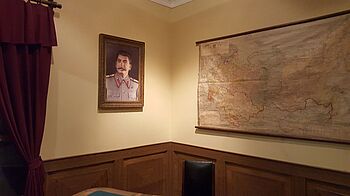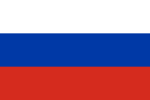Russia was ruled by a communist dictatorship for more than seventy years. Millions of people lost their lives under Joseph Stalin, the head of the Communist Party. And yet many Russians still regard him primarily as the ruler under whose leadership the Soviet Union defeated Nazi Germany. To this day, the dictatorial past lies like a shadow over the country.
The Legacy of the Dictator

Credit: Hubertus Knabe
Russia – officially the Russian Federation – is the largest country in the world, covering an area of about 17 million square kilometers. More than three-quarters of its approximately 144.5 million inhabitants live in the densely populated European part. Much of the Asian part, which is three times larger, is sparsely populated. The majority of the population is Russian Orthodox.
The first Russian empire, the Kievan Rus’, emerged in the 9th century. Its rulers adopted the Christian Orthodox faith shortly before the turn of the millennium. But the empire eventually collapsed and the territory was conquered by the Mongolians in 1240. More than 200 years later, the Grand Prince of Moscow, Duke Ivan III, founded a new Russian empire. Believing himself the successor of the Byzantine emperors, he called himself “tsar” (from the Latin “Caesar” or Greek “Kaisar”). Through several wars the tsardom was extended to the west, east and south. In the 18th century, Russia, whose capital had been moved under Peter the Great from Moscow to Saint Petersburg, rose to become one of the major leading powers in Europe.
During the industrial age, however, Russia’s development lagged behind that of Central and Western Europe. Mass demonstrations, strikes and peasant uprisings led to the first uprising against tsarist rule in 1905. Under the impact of violent protests by workers and soldiers, the tsar abdicated in February 1917 and a provisional government made up of members of parliament took power.
Radical Marxists led by Vladimir Ilyich Lenin and Leon Trotsky organized an armed coup in the Russian capital on October 25, 1917 (November 7 by today’s calendar). A Council of People’s Commissars took power, banning all non-socialist newspapers, nationalizing industry, and creating a new secret police - the Cheka. The new government had several hundred thousand people shot, including the tsar and his family. The freely elected parliament - the Constituent Assembly - was forcibly dissolved at its first meeting in January 1918. The capital was moved back to Moscow.
The October Coup was followed by several years of civil war. The communist Bolsheviks (“Reds”) fought against regiments of noble officers of the old army ("Whites") and various intervention forces. Over twelve million people, mostly civilians, were killed during this time. After their victory, the Bolsheviks founded the Soviet Union in 1922. Two years later, Lenin died and Joseph Stalin gradually established himself as an autocrat.
Stalin's dictatorship lasted more than a quarter of a century. Millions of people were killed as a consequence of his policies. The first major wave of persecution was directed against the peasants, whose land were forcibly collectivized beginning in the late 1920s. Up to 600,000 people fell victim to the fight against the so-called kulaks. These events led to a severe famine (“Holodomor”) in the early 1930s that killed at least 3.5 million people in Ukraine alone.
A second climax came to be known as the Great Terror. According to quotas set by the CPSU Politburo, about 1.5 million people were arrested and some 700,000 executed between 1936 and 1938. Among those executed were dozens of Lenin’s former comrades-in-arms who had been sentenced to death in the Moscow trials, as well as almost half of all Soviet officers. About 350,000 people belonging to ethnic minorities were murdered in so-called national operations.
Many more people fell victim to Stalinist persecution in connection with World War II. After the Hitler-Stalin Pact of 1939, the Soviet Union occupied several neighboring countries and deported several hundred thousand inhabitants to labor camps. Tens of thousands of people were murdered, including over 22,000 captured officers of the Polish army.
More than 25 million Soviet citizens lost their lives following the German invasion of the Soviet Union in 1941. Soviet state and party leader Nikita Khrushchev later held Stalin's policies partially responsible for the heavy losses. 8.6 million Red Army soldiers died in acts of war, and another three million died as German prisoners of war. In addition, at least 15 million civilians were killed. Almost three-quarters of the approximately four million Jews living in German-occupied territories were killed by the occupiers.
But the Soviet Union was also responsible for a high number of deaths unrelated to the war. Between 1941 and 1945, for example, some 2.3 million people of various nationalities were resettled within the Soviet Union, more than 300,000 of whom died. Of the more than three million German prisoners of war in Soviet custody, about one-third perished. The death rate was similarly high among the 272,000 German civilians deported as forced laborers. Many of the two-and-a-half million former Soviet citizens who were repatriated from Western Europe by the Western Allies also died by suicide, execution, or in filtration and labor camps.
After the death of the Soviet dictator on March 5, 1953, his successor Nikita Khrushchev initiated a process of “de-Stalinization.” The “Main Administration of the Camps” (abbreviated: GULag) was formally dissolved in 1956 and about 70 percent of the camp inmates were released. Some 18 million people had been imprisoned in the “Gulag Archipelago,” at least 1.6 million of whom died. The political thaw under Khrushchev ended with his replacement by Leonid Brezhnev in 1964.
Only after Mikhail Gorbachev came to office as party leader in 1985 was it again possible to speak publicly about Stalin’s terror. Fourteen republics of the Soviet Union declared their independence in 1990/91. In 1991, Boris Yeltsin became the first democratically elected head of state to take power in Russia. After a failed coup attempt, the Communist Party was banned from Russia and the Soviet Union was dissolved at the end of the year.
The Russian Federation, as the Russian Soviet Republic began calling itself in 1992, assumed all the rights and obligations of the Soviet Union under international law. Following a referendum, the country acquired a new constitution with a semi-presidential system of government in 1993. The planned economy was replaced by a market economy system with strong state influence.
The 1990s were marked by unusual freedom, but also by crime, corruption and economic decline. In 2000, Vladimir Putin, the former KGB officer and head of the domestic intelligence service, who was currently serving as prime minister, became president of the Russian Federation. Under Putin, Russia once again evolved into an authoritarian regime with a largely state-controlled media and no effective opposition. The Russian leadership now placed the defeat of Nazi Germany at the center of its politics of memory – and consequently, 70 percent of Russians still view Stalin positively today. In December 2021, "Memorial", the most important organisation for coming to terms with the past, was banned (as of January 2022).
Russian Federation

Area: | 17,075,400 km² (without Crimea) |
|---|---|
Inhabitants: | 144.5 million (without Crimea, 2018) |
Population growth: | 0.2 % annually (2012) |
Population density: | 8 inhabitants per km² |
Seat of government: | Moscow |
Official language: | Russian |
Political system: | Semi-presidential system |
Head of state: | President Vladimir Putin (2000-2008; since 2012) |
Head of government: | Prime Minister Mikhail Mishustin (since 2020) |
Freedom status: | 20/100 |
GDP per capita: | 28,184 USD (adjusted for purchasing power, 2019) |
(افغانستان)
(Հայաստան)
(Azərbaycan)
(البحرين)
(বাংলাদেশ)
(မြန်မာ)
(中国)
(საქართველო)
(香港)
(العراق)
(ایران)
(日本)
(الأردن)
(កម្ពុជា)
(قطر)
(Кыргызстан)
(الكويت)
(ປະເທດລາວ)
(لبنان)
(澳門)
(Maldives)
(Federated States of Micronesia)
(Монгол Улс)
(नेपाल)
(조선민주주의인민공화국)
(عمان)
(پاکستان)
(Papua New Guinea)
(Pilipinas)
(Россия)
(대한민국)
(سوريا)
(Тоҷикистон)
(台灣)
(ประเทศไทย)
(Türkiye)
(Україна)
(O`zbekiston)
(الإمارات العربية المتحدة)
(Việt Nam)
(Беларусь)
(اليَمَن)